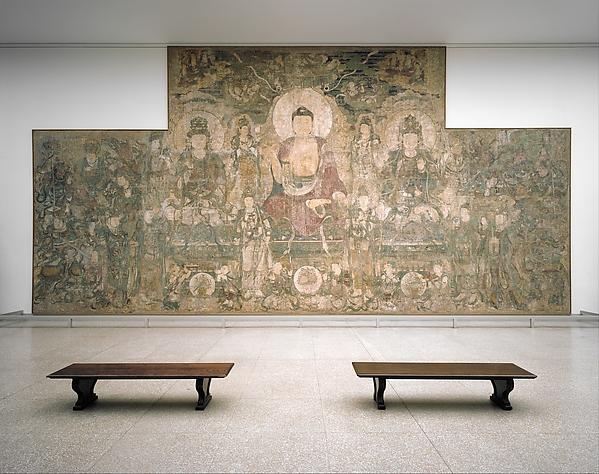在抗日戰爭的烽煙中,興化寺建築最終蕩然無存。但萬幸的是,該寺原本為解一時之困而為的並不光彩的揭取售賣,確實一部分壁畫倖存於人間。下落已知的興化寺壁畫,除故宮所藏《七佛說法圖*》外,尚有一鋪面積更大也更為精彩的《彌勒說法圖**》,漂洋過海,與兩鋪同一風格的平陽府道觀《朝元圖》以及若干精美絕倫的遼金菩薩立像一道,在加拿大多倫多的皇家安大略博物館展廳中熠熠生輝。
*原文連結:https://read01.com/nyoJNm.html
**
Creation[edit]
The famed painter and Buddhist monk, Zhu Haogu (朱好古), along with his pupil Zhang Boyuan (張伯淵), created the dry fresco painting on the southwestern portion of the Xinghua Si (興化寺) monastery during China’s Yuan dynasty.[5] To prepare the monastery wall for this type of painting, it was covered first with a mudded layer of clay, followed by a layer of straw and additional layer of clay, giving the surface a workable texture. From there, a light carbon ink and colour pigments were used to create the image, which would have been copied from a smaller-scale version.[2]
 | |
| Artist | Zhu Haogu (and pupil Zhang Boyuan) |
|---|---|
| Year | Yuan Dynasty (exact date unknown) |
| Type | Dry Fresco |
| Dimensions | 502 cm × 1101 cm (198 in × 433 in) |
| Location | Royal Ontario Museum, Toronto |
***

薬師佛
Buddha of Medicine Bhaishajyaguru (Yaoshi fo)
Period:Yuan dynasty (1271–1368)Date:ca. 1319Culture:ChinaMedium:Water-based pigment over foundation of clay mixed with strawDimensions:H. 24 ft. 8 in. (751.8 cm); W. 49 ft. 7 in. (1511.3 cm)Classification:PaintingsCredit Line:Gift of Arthur M. Sackler, in honor of his parents, Isaac and Sophie Sackler, 1965Accession Number:65.29.2
On view at The Met Fifth Avenue in Gallery 206
Healing practices, physical and spiritual, played an important role in the transmission of Buddhism throughout Asia. In this mural, Bhaishajyaguru (Yaoshi fo), the Buddha of medicine, wears a red robe and is attended by a large assembly of related deities, including two seated bodhisattvas who hold symbols for the sun and the moon. The twelve warriors, six at each side, symbolize the Buddha’s vows to help others. The robust, full-faced figure and the shallow spatial construction are characteristic of the work of Zhu Haogu, who was active in the early fourteenth century and painted both Buddhist and Daoist imagery.
Buddha of Medicine Bhaishajyaguru (Yaoshi fo) | Yuan dynasty (1271 ...
https://www.khanacademy.org/.../buddha-of-medici...
Bhaisajyaguru - Wikipedia, the free encyclopedia
“A museum is a temple of the human condition. To me, it’s just as close to the sacred as I can ever get.” —Artist James Siena on the “Buddha of Medicine Bhaishajyaguru,” the largest painting in the Museum’s collection. http://bit.ly/1SPrqDL #MetArtistProject
沒有留言:
張貼留言